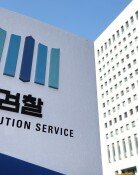Blood reveals the migration of people
Blood reveals the migration of people
Posted January. 03, 2001 16:49,
To find the ancestral roots of one's people, does it necessary mean searching for clues in the ruins high and low across the hot deserts and cold frozen tundra?
In this digital age, our roots can be found through a much simpler blood test at a hospital. Recently, the Korean and Japanese doctors have utilized the Human Leukocyte Antigen (HLA) present in both Koreans and Japanese in order to discover the evolutionary diversion of the two people.
At the Pacific Bone Marrow Transplant Seminar which was held in November last year in Bangkok, Thailand, Professor Kim Dong-Wook of Catholic University Medical School and Professor Okamoto Sinachiro of Japan's Gaio University presented, "The analysis of 170,000 bone marrow donor from the two countries has shown that different groups of people with divergent HLA have passed through China to finally settle separately in Korea and Japan."
How could such analysis be possible through examination of the HLA?
What is the HLA?
It is a marker protein much like an outer tag attached to the cell which works to inform the immune system whether to recognize the cell as its own or a foreign invasive intruder. The protein is a product of the 6th chromosome within the nucleus and works its way out to the cell's outer layer to find its home. The function of the HLA is similar to that of "intelligence agent."
Differences of the HLA among nations' people:
There are three major types of HLA. Each type contains number of variations and when it comes to immune system's response with the major responses categorized as response A, B, and C for Type I, and response DR, DP, and DQ for Type II. When selecting blood for "haematogenetic transfusion" for leukemia patients, the systemic response of the immune system, A, B, and DR, must be in concordance. There are 144 HLA typing for the A-type, 266 for B-type and 313 for DR type. The particular HLA types are inherited and the analysis of the HLA types could yield a possible understanding of racial divergence and movement.
Which nation's people are truly homogenous?
Medically, among the Koreans, the Taiwanese and the Japanese, the most homogenous were the Japanese. Koreans who so proudly consider themselves homogenous were found to be behind the Japanese in terms of being "pure-blooded," followed by the Taiwanese.
Professor Kim stated, "Analysis of whether a recipient for haematogenetic transfusion could find even a single match among the registered donor can yield how close to completely homogenous they are."
Professor Kim analyzed 42,000 registered Korean bone marrow donors, 131,000 Japanese and 178,000 Taiwanese registered with the Ch'uxi. As the number of registered donors could affect the probability of finding a match with the recipient, a projection of Korean registered donors was necessary for a comparison match-up with 120,000 donors. The result revealed 70% probability of a match for Koreans, 80% match for Japanese, and 50% match for the Taiwanese.



![“한동훈, 정치생명 걸고 무소속 출마해 평가받는 것 고려할만”[정치를 부탁해]](https://dimg.donga.com/c/138/175/90/1/wps/NEWS/IMAGE/2026/01/19/133186982.1.jpg)


![[한규섭 칼럼]왜 여당 지지율은 떨어지지 않는가](https://dimg.donga.com/c/138/175/90/1/wps/NEWS/IMAGE/2026/01/19/133189257.1.png)
